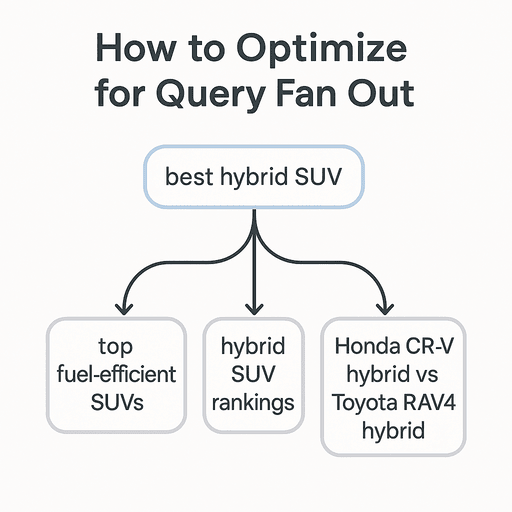How to Optimize for Query Fan Out in AI Search

Short Answer: Query fan out is when one search intent branches into many different query variations. To optimize for it, you need content that covers entities, facts, and context, not just one keyword.
Introduction: Why Query Fan Out Matters in 2025
Every search no longer ends with one straight answer. Today, one question sparks a web of possibilities. Type in a phrase like “best hybrid SUV” and search engines don’t just return that — they expand it into dozens of related queries, comparisons, and AI-generated overviews.
This branching effect is called query fan out, and it’s reshaping how content is discovered. If your content only targets a single phrase, you risk being invisible. But if you optimize for query fan out, your page can surface across AI Overviews, semantic search, and generative results, putting you in front of more users at more stages of their journey.
What Is Query Fan Out?
Query fan out happens when a single question or intent creates multiple related queries.
For example, if someone searches “best hybrid SUV,” search engines may also look at:
-
“top fuel-efficient SUVs”
-
“hybrid SUV rankings”
-
“Honda CR-V hybrid vs Toyota RAV4 hybrid”
This process is called search query clustering. It’s how multi-intent search queries get expanded into dozens of variations. Instead of focusing on one keyword, you need to build content that can meet all those connected intents.
SEO experts like Aleyda Solis explain Google’s query fan out in depth, showing how one intent can trigger an entire network of related searches.
How Search Engines Handle Query Fan Out
Search engines use semantic search query expansion to connect related terms. Google, Bing, and AI-powered assistants pull in entities, synonyms, and fact-based relationships.
For instance, Google’s AI Overviews don’t just repeat a keyword. They pull from fact coverage SEO signals, entities, and semantic context. That means ranking is no longer about keyword stuffing — it’s about proving your page is the most reliable source of information within a query cluster.
This is also where Answer Engine Optimization (AEO) and Generative Engine Optimization (GEO) come in. Both approaches focus on giving AI the facts and structure it needs to cite your content.
Core Strategies to Optimize for Query Fan Out
1. Build Entity-First Content
Entities are the “who, what, where” of your topic. Instead of only targeting one keyword, focus on covering entities like product names, locations, and features.
For example, instead of just writing “Honda CR-V towing capacity,” also mention related entities: “CR-V trailer hitch,” “Honda SUV towing guide,” and “tow ratings.” These make your content stronger across semantic relationships in search.
2. Expand Beyond Exact Keywords
With long-tail keyword fan out, people ask questions in dozens of ways. Cover variations naturally by including headings, FAQs, and examples.
Don’t only optimize for “SEO query fan out.” Include connected phrases like “query fan out search optimization” and “multi-intent search queries.” This helps your content stay visible across search intent diversification.
3. Cover Fact Clusters and Semantic Context
AI Overviews rely on fact coverage SEO. If you only mention one fact, you risk being ignored. Instead, include clusters of related data, comparisons, and statistics.
The more semantic context you provide, the more likely your content will appear when a search fans out into multiple directions.
4. Optimize for Generative Engines
Search is moving toward generative AI, not just links. To rank in AI Overviews query fan out, structure your content for GEO, AEO, and even OSO (Offline Search Optimization).
That means:
-
Clear, factual sections
-
Entity-rich language
-
Easy-to-pull summaries (lists, tables, short answers)
This makes it easier for AI engines to pull from your site as a trusted source.
Case Example: Query Fan Out in Action
Let’s say a user searches for Honda CR-V towing capacity.
Instead of showing only that phrase, Google and AI Overviews may also surface:
-
“CR-V tow rating”
-
“Honda SUV towing guide”
-
“CR-V trailer hitch options”
If your content covers just one keyword, you’ll miss out. But if your article includes all these query variations, your chances of being featured in both traditional SEO and AI results rise dramatically.
FAQs About Query Fan Out
What is query fan out in SEO?
It’s when one intent turns into many different search queries.
Why does query fan out matter for AI Overviews?
Because AI relies on semantic query expansion and fact coverage, not just one keyword.
How can businesses prepare for query fan out?
By writing entity-rich, fact-focused content that answers questions in multiple ways.
Conclusion: Future-Proof Your SEO with Query Fan Out
SEO in 2025 is no longer about ranking for one keyword. It’s about owning the entire query cluster. By optimizing for query fan out, you’ll strengthen your presence across blue links, AI Overviews, and generative engines.
If you want content that prepares your business for the future of AI-driven search, contact me today. I’ll help you create SEO content built for query fan out, entities, and unified strategies.

0 Comments Add a Comment?